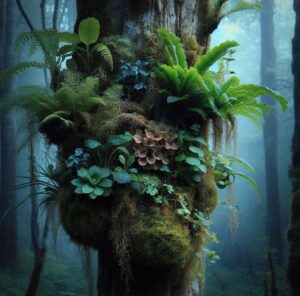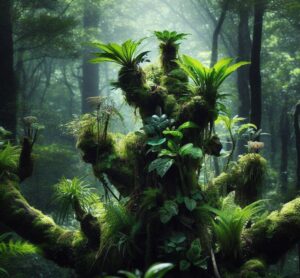The beauty and complexity of Native Woodlands lie not only in their towering trees and diverse wildlife but also in their intricate ecological tapestry of symbiotic relationships. One such fascinating interaction is the one that involves certain plants that live on trees, or “epiphytes.” Far from being parasitic, these plants form a vital part of our woodland ecosystems in ways that might surprise you.
Understanding Epiphytes

Contrary to the conventional image of plants deeply rooted into the soil, epiphytes take a climber’s approach to survival. With a knack for finding support amongst the branches, trunks, and even the leaves of trees, they hoist themselves towards the skies. This unusual lifestyle does not spring from a parasitic tendency. Unlike parasites, which harm their hosts by draining nutrients, epiphytes are merely opportunistic dwellers. They use the host trees mainly for physical support – a platform towards a life in the sunlit canopies, far above the competitive clutter of the forest floor.
Epiphytes extract their sustenance not from the tree, but from other sources. They derive their necessary nutrients and water from the air, the rain, or from the organic debris that gathers around them. They’ve adapted to harvest these elements efficiently from their airborne lifestyle – an impressive testament to nature’s versatility.
The term “epiphyte” cuts a vast swath through the biodiversity of our plant kingdom. This group is a marvelous and diverse collective that accommodates many types of plants. Take ferns, for instance, which have evolved unique ways to conserve water through their frond design and rhizomes. Or consider the vast family of orchids, cherished for their stunning floral displays, alluring scents and intricate pollination strategies. Bromeliads too, with their remarkable rosette structure forming a rain-capturing reservoir – a private source of water and nutrients. Mosses and lichens also feature in this airborne communal, both groups forming a dense, spongy layer over branch and bark, each creating their micro-habitats.
From delicate ferns fluttering in the breeze to the vibrant bursts of orchid flowers, the communities of epiphytes stand as a testament to the richness of life within the lofty heights of native woodlands.
Epiphytic Habitats
Perched on branches way up high in the tree canopies, epiphytes occupy a unique ecological niche. In contrast to their ground-level counterparts, epiphytes face greater exposure to light, wind, and rain. Their lofty homes don’t give them direct access to nutrient-rich soil. Instead, they have evolved remarkable strategies to collect nutrients and water, such as specialized roots to absorb water from the humid atmosphere, and leaves designed to capture and store rainwater.
Roles and Importance of Epiphytes in the Ecosystem

Epiphytes are far more than just forest adornments. These cleverly adapted plants are dynamic participants in the rich tapestry of the forest ecosystem, playing multiple vital roles that underline their importance for overall biodiversity.
One of the most significant functions of epiphytes is the creation of microenvironments, or “mini-ecosystems”. These unique environments, perched above the forest floor, often shelter a variety of creatures. These lofty domiciles provide homes and feeding grounds for a wide range of organisms. Insects, spiders, frogs, and even birds leverage these suspended gardens, taking advantage of the water-filled cups of bromeliads, the sheltering nooks of twisted orchid roots, or the dense cover of fern colonies. Certain bird species use these conveniently located platforms for nesting, bringing a flurry of feathery life to the forest canopies.
The role of epiphytes extends beyond providing shelter; they are integral to the nutrient cycle of the forest ecosystem. The exceptionally absorbent root mats of these high-rise dwellers, paired with the organic debris accumulated in their host trees, lead to the formation of nutrient-rich ‘canopy soils.’ These are reservoirs of organic matter which, in turn, bear nutrients that trickle down, either through decomposition or through rainwater, to the forest floor below. This process furnishes the understory plants with essential nutrients and helps maintain the overall health of the forest.
The structure and growth of epiphytes can also influence the microclimate around them by absorbing sunlight and reducing wind speed, thereby contributing to the regulation of temperature and humidity levels within the forest canopy. These finely-tuned microclimate conditions can promote the growth and survival of other plant and animal species.
The roles and importance of epiphytes in the ecosystem extend far beyond their exotic and picturesque appeal. These plants, though unassuming in their lofty homes, are anchors in the wind of ecological interactions, promoting biodiversity and significantly influencing the health of our precious native woodlands.
Notable Epiphytes in Native Woodlands
Native woodlands are a haven for an intriguing assortment of epiphytic plants. Each of these inhabitants adds a unique texture and story to the rich fabric of the biodiversity presiding over the forest floor.
Consider the Resurrection Fern, an aptly named epiphyte found sprawling across the limbs of host trees in temperate and tropical rainforests. This remarkable plant can withstand extreme dehydration, losing up to 90% of its water during periods of drought – a condition that would be lethal for most other plant species. Yet, it does not perish. Instead, it enters a kind of hibernation, curling its fronds and appearing brown and dead. Within hours of receiving water, the fern ‘resurrects’, recovering its verdant luster – a testament to nature’s resilience.
Then, of course, there are the stunning epiphytic orchids – jewels of the forest canopy. These plants are famed for their vibrant colors, intricate shapes, and often intoxicating fragrances, making them an irresistible magnet for pollinators. Their nectar and pollen-rich blooms serve as an ecosystem service, enticing a multitude of insects and birds, thereby facilitating pollination and promoting richer biodiversity.
Bromeliads, another notable group of epiphytes, are renowned for their cone-shaped rosette, which creates a central ‘tank’. This clever adaptation allows these plants to collect and store rainwater, permitting them to endure seasonal discrepancies in rainfall. But this tank serves more than just the bromeliads themselves; it also becomes a vital resource for a variety of canopy dwellers. Insects, amphibians, and even birds use these natural reservoirs as watering holes, aiding survival amidst the lofty heights of the trees.
These are just a few examples of the notable epiphytes that enrich native woodlands, each complete with their ecological prowess and unique survival mechanisms that collectively contribute to the vitality of the ecosystem they inhabit. They reflect the various ingenious strategies that life has evolved to exploit and endure in the diverse conditions presented by the forest canopies.